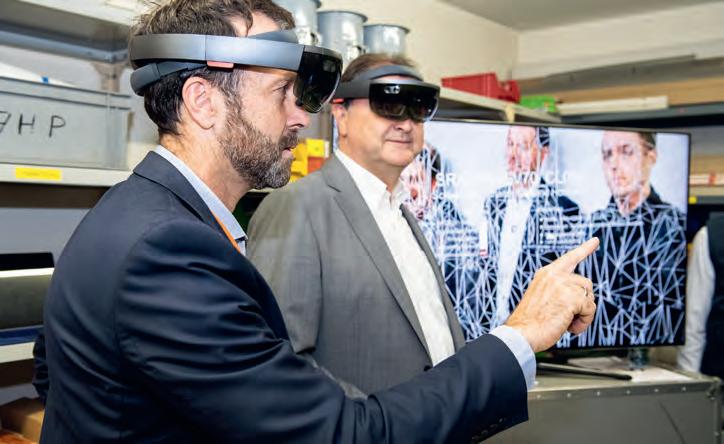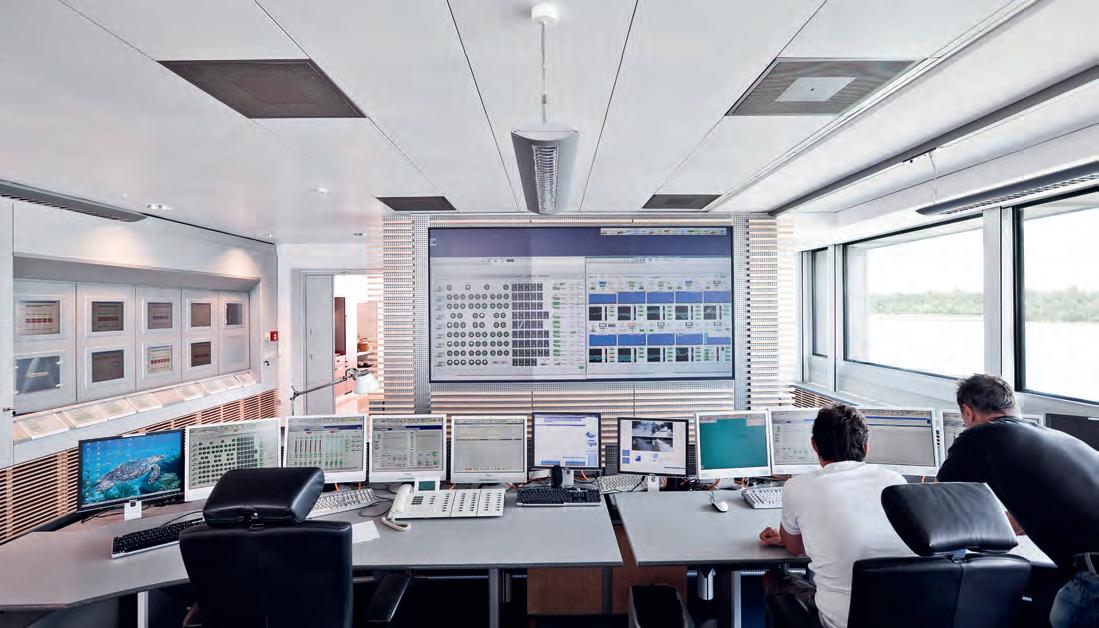
12 minute read
VERBUND puts Europe‘s highest fish ladder into operation [ ECOLOGY
from zek HYDRO 2021
by zek Magazin
VERBUND puts Europe‘s highest fish ladder into operation at the Drava power plant Annabrücke. It allows the fish in the Drava to scale an impressive 26 metres height.
The fish can migrate both up and downstream with the help of an elaborate system of 172 small pools. photo credits: VERBUND
40 years after its construction, the Annabrücke power plant on the river Drava is being upgraded with a brand new fish migration aid. The fish can migrate up and downstream through an elaborate system of 172 small pools. A video system monitors them online.
As Austria‘s largest hydropower operator, we are aware of our responsibility to protect the environment and have been proving that all requirements can be reconciled with top performance for decades. We are implementing long-term plans to improve the ecology of Austria‘s rivers with our partners wherever possible, even in these difficult times. We are setting new standards in Europe with our measures; in 2018 with the longest fish migration aid and now in 2020 with the tallest fish migration aid,“ says Achim Kaspar, the Managing Board member responsible for generation at VERBUND. VERBUND is investing a total of around EUR 280 million in making its more than 130 hydropower plants more ecological, thereby also making a valuable contribution to stimulating the economy. „Habitat creation and linkage is an essential element in the conservation and enhancement of biodiversity in our water bodies. Since 2009, we have constructed more than 1,000 fish ladders for the National Water Management Plans, and many new ones are in the planning or implementation stages. The new fish migration aid in Annabrücke ascends 26 metres in height, making it the tallest in Europe. The Federal Ministry of Agriculture,

photo credits: VERBUND
photo credits: joakant / pixelio.de From right: Sabine Käfer (project manager, VERBUND), Mayor Hannes Mak (Gallizien), Mayor Stefan Deutschmann (Grafenstein), Karl Heinz Gruber (VERBUND Hydro Power GmbH), Achim Kaspar (VERBUND AG), Reinhard Rohr (Carinthia), Daniel Fellner (Carinthia), Günter Liebel (Ministry of Agriculture and Tourism)

Migratory aids are important to maintaining the biodiversity of the fish fauna.

Regions and Tourism has funded the project with EUR 450,000,“ highlighted Federal Minister Elisabeth Köstinger on the occasion of the ceremonial opening. State Parliament President Reinhart Rohr also expressed his pleasure: „Things are looking up in Carinthia not only for the fish, but also for environmental protection! During my time serving as the Environmental Officer of the Province of Carinthia until 2010, I initiated the first steps in this area. Now, ten years later, all of Carinthia is proud to be able to open the tallest fish migration aid in Europe. Making use of nature while at the same time respecting its needs is the promising path for a sustainable Carinthia – and with this project we have once taken again a decisive step forward.“
28 MILLION EUROS TOWARDS BARRIER-FREE POWER PLANTS IN CARINTHIA „Hydropower is rightly considered the cleanest form of energy generation. We strive to keep our facilities up to date with the latest technical and ecological standards, and this of course includes the creation of fish migration passages. Doing so means giving nature back a piece of biodiversity, even on heavily modified bodies of water,“ says Karl Heinz Gruber, Managing Director of VERBUND Hydro Power GmbH. The commissioning of the fish migration aid at the Annabrücke power plant means that 8 of the 10 Drava power plants are once again passable for fish. Complete continuity over a stretch of 260 kilometres should be possible by 2022. „The migration aid currently under construction at the Ferlach power plant is scheduled to go into operation in autumn 2021, and the last one at the Feistritz power plant will be ready by September 2022,“ adds Gruber. VERBUND is investing around EUR 28 million in ecological measures in Carinthia on the Drava and at its Malta and Reißeck storage power plants between now and 2022. The fish migration aid Annabrücke accounts for EUR 3.5 million of this, including planning and monitoring measures.
photo credits: VERBUND NEW STANDARDS IN STRUCTURAL IMPLEMENTATION There is a height difference of 26 metres between the top and bottom of Drava power station Annabrücke. In order for fish to be able to scale this height, an elaborate system of 172 concrete pools and 21 resting pools is needed. The pool structure is specially designed for the range of fish species found in the Drava and has very low flow rates in the individual sections. The double slot ensures that the water movement is always calm. This helps the fish to save energy. The natural riverbed in the fish migration aid is a valuable habitat for microorganisms and tiny creatures such as larvae and other sources of food for fish. The fish migration aid is actually a migration corridor, as all aquatic life can use this route. The ascent aid is particularly important for fish that migrate over medium distances, which undertake extensive upstream breeding migrations of up to several 100 km to find suitable breeding grounds and then return to their original habitats downstream.
A total of several hundreds of thousands of fish have been recorded so far. This proved that all fish species found in the Drava, including smaller and juvenile fish that are weak swimmers, are already successfully migrating through the fish migration aids. photo credits: VERBUND

OPERATIONAL CHECK SUCCESSFUL Each fish migration aid on the Drava is verified through extensive monitoring of fish ecology after its completion. This includes recording fish migration by means of video monitoring in a contact-free, stress-free manner that does not disturb the fish. There is a short video sequence of each fish that passes through the fish migration aids. The exact time, fish species, length and direction (ascent or descent) are determined and recorded in a database. A total of several hundreds of thousands of fish have been recorded so far. This proved that all fish species found in the Drava, including smaller and juvenile fish that are weak swimmers, are already successfully migrating through the fish migration aids. We are particularly pleased with the documented upward migration of the „assessment fish“. Several catfish with lengths over 120 cm have already been registered.
photo credits: VERBUND
The live demonstrations at the Styrian pilot plant in Rabenstein are unique in Europe. VERBUND has joined up with the European Association of Power Stations, the Technical University of Graz and other technology partners to showcase the future of electricity production at the first ‘Digital Hydropower Plant 4.0’.

HYDROPOWER 4.0 – IMPLEMENTING IMAGINATION
VERBUND is pioneering the hydropower plant of tomorrow – today, in the Styrian village of Rabenstein, analysing the efficacy of concepts such as ROVs, smart glasses, digital twins and the future of servicing – predictive maintenance.
Anyone gazing down the Mur river valley towards Graz from the rocky hillside in Frohnleiten can imagine the journey in time from the Middle Ages into the 3rd millennium. Rabenstein castle, built on a rocky outpost in the 12th century, towers above the valley as, further down the river, a remote operated underwater vehicle (ROV) is lowered into the water to make an extremely precise approach towards the runner of the approximately 100metricton tubular turbine at the hydroelectric power plant. Anomaly detectors transmitted sensor data from the machine group and triggered the alarm, having detected an immense curtailment of the expected working life of essential parts fitted in the digital twin. The operational engineers reacted without delay, immediately shutting down the turbine to conduct a quick inspection. This was carried out by a realtime 3D sonar unit, eliminating the need to send divers on dangerous exploratory missions to examine the inlet basin of the machinery in freezingcold water. The sonar can operate without restrictions in murky water, navigating unproblematically via acoustic signals, however poor the visibility for divers, and providing a glimpse of work in tomorrow’s hydroelectric power stations.
Verbund board director Achim Kaspar on digital hydropower:
“The digital hydropower plant is a rethink and redesign of hydropower to face the challenges posed by the energy transition and the requirements of the future. We aim to evaluate every imaginable application of digitalisation in hydroelectric power stations, to test the most promising technologies intensively at the Rabenstein pilot plant, and to implement them successfully. To realise these goals, we are developing them in cooperation with the industrial sector and international partners.”
DIGITAL INTELLIGENT
What may sound futuristic – is increasingly becoming reality at VERBUND’s Styrian Rabenstein Mur river power plant. The runofriver plant first went online in 1987. Since 2018 it has assumed a unique role in Europe as a venue for the implementation of pioneering digital technologies. Achim Kaspar, VERBUND board director responsible for digitalisation and production, explains: “We aim to evaluate every imaginable application of digitalisation in hydroelectric power stations to test the most promising technologies intensively at our pilot plant and implement them successfully at all Verbund operations.” In Rabenstein, Project Manager Bernd Hollauf and his team are working with the concerted support of the station’s team on the testing of a dozen applications that bring together the
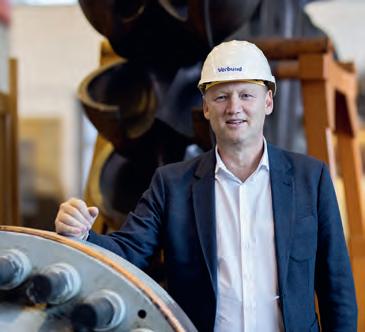
The ‘Digital Power Plant’ is a pilot project that also involves the testing and development of ideas on how to digitalise certain functions in the real environment of the Rabenstein hydropower plant, and establish to what degree findings can be implemented at other power plants.
fields of automation and intelligent data processing. For VERBUND the goal and the road ahead are as clear as they are challenging – to evaluate the most promising technologies at the pilot plant and test them to their limits. The variety of technologies in question ranges from intelligent sensorics, predictive models, digital twins, mobile assistance systems, pioneering autonomous surveying and inspection concepts – to interconnected platform solutions.
EFFICIENCY WITH FORESIGHT
Intelligent partacoustic surveillance systems with AI capacities are to be used to provide data that form the basis of anomaly detection and prognosis models – to detect potential machine breakdowns. Digital twins process sensor data in realtime simulations to predict the remaining working life of important machine components, as well as exploring the possibilities of other operational uses – and their effects. The buzzword for this potential is predictive maintenance and it’s the future of industrial servicing and repair. Predictive maintenance can remove the limitations of reactive approaches – responding when a break down has already occurred, and of preventative maintenance – requiring preventative measures according to inflexible timetables. Predicting failures enables the active interception of impending breakdowns and damages, and the optimisation of plant efficiency. In a hydropower plant this is particularly beneficial as regards generators and turbines. As essential components in the process of electricity generation they are required to work reliably and without interruptions, since any kind of downtime or damage can result in an immense loss of productivity. An innovative inspection system uses a camera in combination with artificial intelligence to register negative changes within the generator before they become critical.
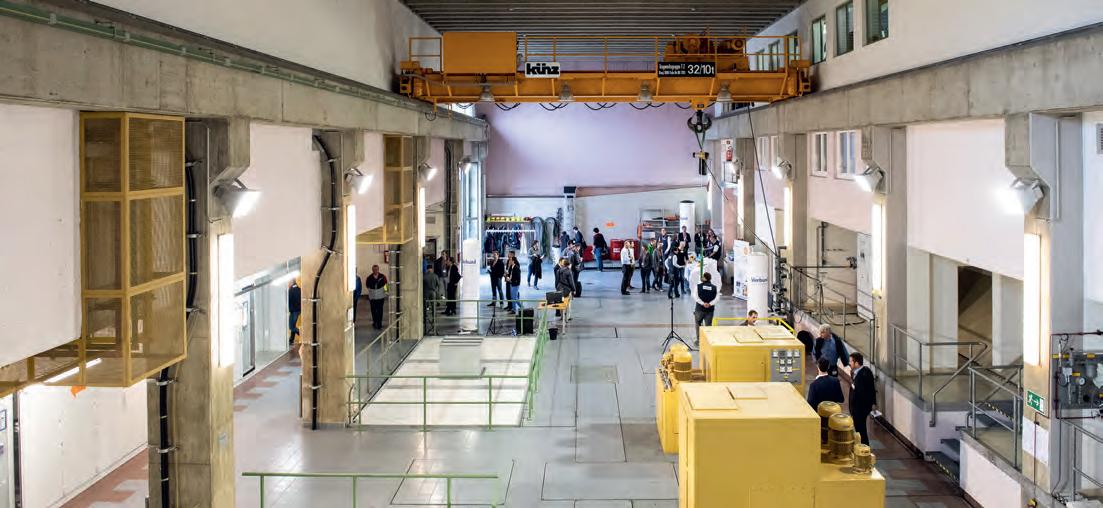
PROACTIVE PRODUCTIVITY
The benefits of predictive maintenance are obvious as the ideal moments for repair and maintenance activities can be scheduled before problems occur. This means service staff and spare parts can be deployed efficiently, and the losses of profit caused by machine downtimes can be eradicated. In terms of maintenance, staying ahead of the game enhances overall machine performance and the working life thereof. Another key positive is that any changes to the plant’s modes of operation, and the
Foto: CKW
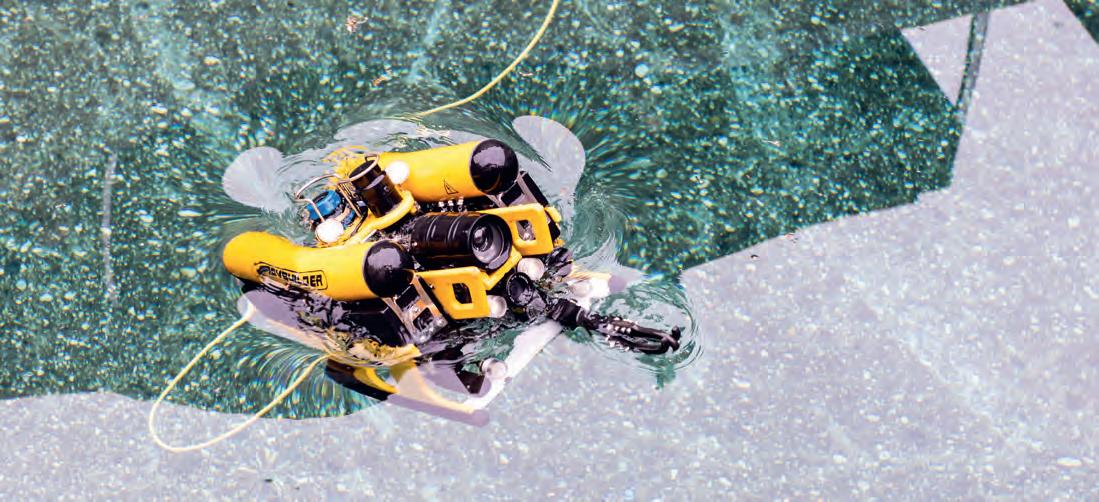
Smart glasses have great potential for interactive troubleshooting.
ways in which they burden components, can be fed into the digital twin to calculate the effects on parts in advance. This gives plant operations greater transparency – and the reduction in power station downtimes and breakdowns will lead to greater power supply reliability. When there are unavoidable service failures, mobile assistance systems can provide all the information necessary for repair work to the respective power station in realtime. The uses of tablets, smartphones and smart glasses are all being explored within this context at the Rabenstein plant. Overall, the plan is to realise completely new means and modes of troubleshooting; ones with which plant operatives can use their mobile devices to gain access to all the relevant data on a specific part of the plant, request and receive assistance from colleagues online, and digitally document the entire procedure on site. The question of whether smart glasses or tablet technology prevail here has not yet been resolved.
HYDROPOWER 4.0
A key point of emphasis at the pilot plant is the insistence upon partnerships with the industrial sector in the field of development, and on international cooperation agreements with manufacturers and research facilities. The work being promoted in Rabenstein is part of VERBUND’s broad crosssection of efforts towards automation and digitalisation; a field in which it is a European pioneer. The work encompasses the documentation of items such as central operational data records, remote control of all 131 power plants, automatic status monitoring of key electrical and mechanical components and the optimisation of machine usage. VERBUND is now managing and observing a wide range of aspects of everyday plant activity, partly via mobile devices – including seamless online surveillance of dam walls, digital recording of surveying and hydrography data, and also SAPbacked maintenance planning and implementation. Back in 2018, a multimillion digitalisation package was initiated on the road to the ‘transparent hydropower plant’. The objectives are the harmonisation of operational and maintenance processes, their digital portrayal, simplification of the work done in power stations, eradication of the jumps made from one medium to another (Digital Workforce Management), and the gradual implementation a Rabensteintype digital power plant concept at other VERBUND sites. “Hydropower is very technically sophisticated, but it’s obvious there’s still potential for further improvement. We’re rethinking the hydropower concept with our digital power plant to serve this goal, to be ready to face future challenges, and to be armed to meet the requirements set by the energy transition ahead,” states Achim Kaspar succinctly. Digitalisation is a tool for reducing the difficulties and raising the efficiency levels involved in such work. However, skilled expertise and specialised planning knowhow will continue to be indispensable; a requirement as abiding as the view of the castle high on the hill.
The advancing digitalization opens up new concepts for the future.
